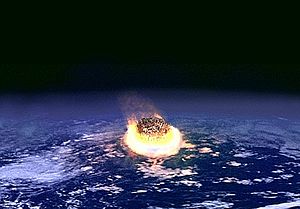Permian–Triassic extinction event facts for kids

The Permian-Triassic extinction event (P/Tr for short) was the biggest extinction event ever recorded on Earth. It happened about 252 million years ago. This event caused a huge loss of life. About 96% of all ocean creatures and 70% of land animals with backbones disappeared. This massive extinction marked the end of the Paleozoic era and the start of the Mesozoic era, which is sometimes called the "Age of Dinosaurs." Because so many living things died out, it took a very long time for life on Earth to recover. Scientists often call this event the "mother of all mass extinctions."
Contents
What Caused the Great Dying?
Scientists are still studying exactly what caused this huge extinction. They have several ideas, and it might have been a combination of things.
Giant Volcanoes Erupting
One of the most likely causes was a series of massive volcanic eruptions. These eruptions happened in a place called the Siberian Traps in Siberia. They started around 251 million years ago and lasted for about a million years. These were not just small eruptions; they were some of the largest flood basalt eruptions in Earth's history.
How Volcanoes Changed the World
When these volcanoes erupted, they released huge amounts of gases and dust into the air. This would have caused major changes to Earth's climate.
- It could have made the planet much hotter.
- It might have led to oceanic anoxic events, where the oceans lost most of their oxygen. This would have killed off many marine animals.
- The eruptions could have also caused acid rain, harming plants and animals on land.
Other Possible Causes
While the Siberian Traps are thought to be the main reason, other ideas have been suggested:
- Meteorite Impacts: One or more large meteorite impacts could have caused widespread destruction and climate change.
- Methane Release: A sudden release of methane gas from the sea floor could have warmed the planet very quickly. Methane is a powerful greenhouse gas.
- Sea Level Changes: Changes in sea level could have affected coastal habitats and ocean currents.
- Increasing Dryness: The world might have become much drier, leading to more arid (desert-like) conditions.
Recovery of Life
After the Permian-Triassic extinction, it took millions of years for life on Earth to recover. The few species that survived slowly began to repopulate the planet. This event cleared the way for new types of animals to evolve, including the first dinosaurs, which would later dominate the Mesozoic era.
Other pages
Images for kids
-
Permian–Triassic boundary at Frazer Beach in New South Wales, with the End Permian extinction event located just above the coal layer
-
Sessile filter feeders like this Carboniferous crinoid, the mushroom crinoid (Agaricocrinus americanus), were significantly less abundant after the P–Tr extinction.
See also
 In Spanish: Extinción masiva del Pérmico-Triásico para niños
In Spanish: Extinción masiva del Pérmico-Triásico para niños





